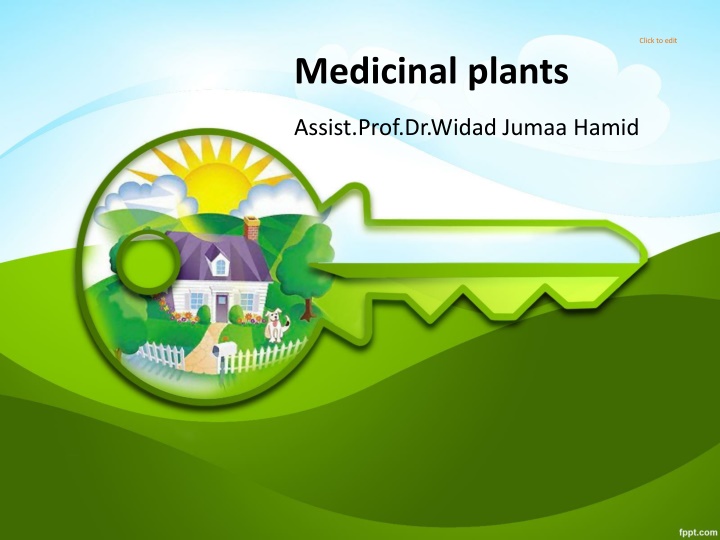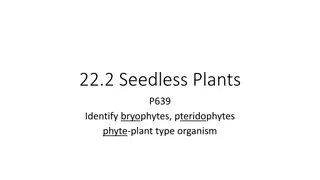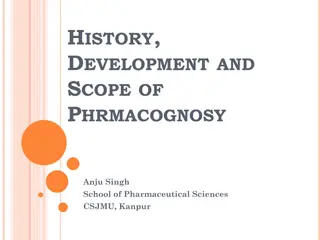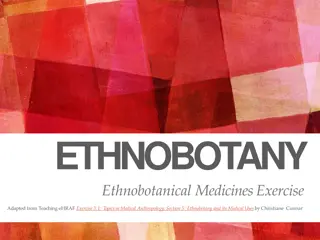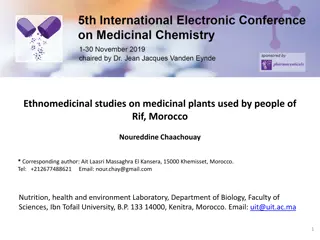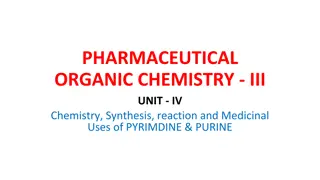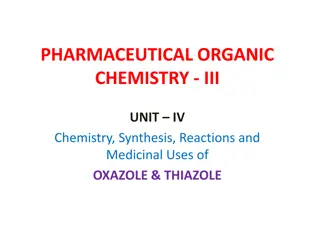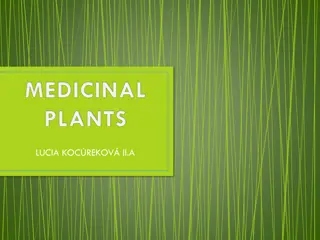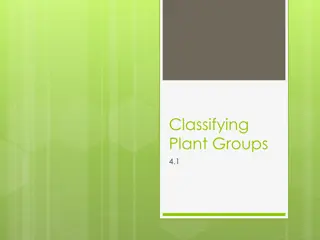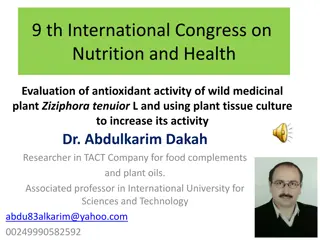The Fascinating World of Medicinal Plants Through History
Explore the ancient origins and diverse uses of medicinal plants in treating diseases, from prehistoric times to modern societies. Discover how these natural remedies have played a crucial role in healthcare practices worldwide. Learn about the historical records, cultural significance, and scientific importance of herbal medicines, showcasing the profound impact of nature's pharmacy on human wellness.
Download Presentation

Please find below an Image/Link to download the presentation.
The content on the website is provided AS IS for your information and personal use only. It may not be sold, licensed, or shared on other websites without obtaining consent from the author.If you encounter any issues during the download, it is possible that the publisher has removed the file from their server.
You are allowed to download the files provided on this website for personal or commercial use, subject to the condition that they are used lawfully. All files are the property of their respective owners.
The content on the website is provided AS IS for your information and personal use only. It may not be sold, licensed, or shared on other websites without obtaining consent from the author.
E N D
Presentation Transcript
Click to edit Medicinal plants Assist.Prof.Dr.Widad Jumaa Hamid
Medicinal plants, medicinal herbs, or simply herbs have been identified and used from prehistoric times. Plants make many chemical compounds for biological functions, including defence against insects, fungi and herbivorous mammals. Over 12,000 active compounds are known to science. These chemicals work on the human body in exactly the same way as pharmaceutical drugs, so herbal medicines can be beneficial and have harmful side effects just like conventional drugs. However, since a single plant may contain many substances, the effects of taking a plant as medicine can be complex.
The earliest historical records of herbs are found from the Sumerian civilisation, where hundreds of medicinal plants including opium are listed on clay tablets. The Ebers Papyrus from ancient Egypt describes over 850 plant medicines, while Dioscorides documented over 1000 recipes for medicines using over 600 medicinal plants in De materia medica, forming the basis of pharmacopoeias for some 1500 years. These include the common drugs aspirin, digoxin, quinine, and opium. The compounds found in plants are of many kinds, but most are in four major biochemical classes, the alkaloids, glycosides, polyphenols, and terpenes.
Medicinal plants are widely used to treat disease in non-industrialized societies, not least because they are far cheaper than modern medicines. The annual global export value of pharmaceutical plants in 2012 was over US$2.2 billion https://upload.wikimedia.org/wikipedia/commons/thumb/4/4c/Arabic_herbal_medicine_guidebook.jpeg/220px-Arabic_herbal_medicine_guidebook.jpeg Dioscorides's 1st century De materia medica, seen here in a c. 1334 copy in Arabic, describes some 1000 drug recipes based on over 600 plants. Main articles: History of herbalism and History of pharmacy
Prehistoric times Plants, including many now used as culinary herbs and spices, have been used as medicines from prehistoric times. Spices have been used partly to counter food spoilage bacteria, especially in hot climates and especially in meat dishes which spoil more readily. Angiosperms (flowering plants) were the original source of most plant medicines .Human settlements are often surrounded by weeds useful as medicines, such as nettle, dandelion and chickweed .Humans were not alone in using herbs as medicines: some animals such as non-human primates, monarch butterflies
monarch butterflies and sheep ingest medicinal plants to treat illness. For instance, a 60 000-year-old Neanderthal burial site, "Shanidar IV", in northern Iraq has yielded large amounts of pollen from 8 plant species, 7 of which are used now as herbal remedies. A mushroom was found in the personal effects of tzi the Iceman, whose body was frozen in the tztal Alps for more than 5,000 years. The mushroom was probably used to treat whipworm.
The Ebers Papyrus (c. 1550 BC) from Ancient Egypt describes the use of hundreds of plant medicines https://upload.wikimedia.org/wikipedia/commons/thumb/e/e4/PEbers_c41-bc.jpg/170px-PEbers_c41-bc.jpg
In ancient Sumeria, hundreds of medicinal plants including myrrh and opium are listed on clay tablets. The ancient Egyptian Ebers Papyrus lists over 800 plant medicines such as aloe, cannabis, castor bean, garlic, juniper, and mandrake. From ancient times to the present used hundreds of pharmacologically active herbs and spices such as turmeric, which contains curcumin
Middle Ages In the Early Middle Ages, Benedictine monasteries preserved medical knowledge in Europe, translating and copying classical texts and maintaining herb gardens.Hildegard of Bingen wrote Causae et Curae ("Causes and Cures") on medicine In the Islamic Golden Age, scholars translated many classical Greek texts including Dioscorides into Arabic, adding their own commentaries Herbalism flourished in the Islamic world, particularly in Baghdad and in Al-Andalus. Among many works on medicinal plants,
, Abulcasis (9361013) of Cordoba wrote The Book of Simples, and Ibn al-Baitar (1197 1248) recorded hundreds of medicinal herbs. Avicenna included many plants in his 1025 The Canon of Medicine. Abu-Rayhan Biruni, Ibn Zuhr, Peter of Spain, and John of St Amand wrote further pharmacopoeias https://upload.wikimedia.org/wikipedia/en/thumb/2/29/The_Grete_Herball%2C_Title_Page%2C_1526.jpg/170px-The_Grete_Herball%2C_Title_Page%2C_1526.jpg
The Early Modern period saw the flourishing of illustrated herbals across Europe, starting with the 1526 Grete Herball. John Gerard wrote his famous The Herball or General History of Plants in 1597, based on Rembert Dodoens, and Nicholas Culpeper published his The English Physician Enlarged. Many new plant medicines arrived in Europe as products of Early Modern exploration and the resulting Columbian Exchange, in which livestock, crops and technologies were transferred between the Old World and the Americas in the 15th and 16th centuries. Medicinal herbs arriving in the Americas included garlic, ginger, and turmeric; coffee, tobacco and coca travelled in the other direction In Mexico, the sixteenth century Badianus Manuscript described medicinal plants available in Central America.
7 Medicinal Plants You Can Use to Benefit Your Health Below is an excellent starting point to learn how to harness the power of medicinal plants. This is only a small sample, of course, and once you get your feet wet, you'll likely be inspired to explore more and more uses for these healing wonders. https://upload.wikimedia.org/wikipedia/commons/thumb/d/d3/Benjamin_Rush_Medicinal_Plant_Garden_-_IMG_7245.JPG/290px-Benjamin_Rush_Medicinal_Plant_Garden_-_IMG_7245.JPG https://upload.wikimedia.org/wikipedia/commons/thumb/3/31/Marrakech_103.JPG/220px-Marrakech_103.JPG
1. Ginger Ginger is one spice that recommend keeping on hand in your kitchen at all times. Not only is it a wonderful addition to your cooking (especially paired with garlic) but it also has enough medicinal properties to fill several books. Ginger is best known for its antinausea effects but also has broad-spectrum antibacterial, antiviral, antioxidant, and anti-parasitic properties, to name just several of its more than 40 scientifically confirmed pharmacological actions. It is anti- inflammatory, making it valuable for pain relief for joint pain, menstrual pain, headaches, and more.
http://www.vvexports.in/uploads/dry-ginger-776994.jpg Dry Ginger
The pain-relieving potential of ginger appears to be far-reaching. Along with help for muscle and joint pain, ginger has been found to reduce the severity of migraine headaches as well as the migraine medication Sumatriptan with fewer side effects. Ginger also shows promise for fighting cancer, diabetes, non-alcoholic fatty liver disease, asthma, bacterial and fungal infections, and it is one of the best natural remedies available for motion sickness or nausea (from pregnancy or chemotherapy, for example).
Taking one gram of ginger daily may help reduce nausea and vomiting in pregnant women, or those with migraines and ginger has been shown to work better than a placebo in relieving morning sickness. Ginger is also a must-have if you struggle with indigestion, and it does more than simply relieve pain. Ginger contains powerful protein-digesting enzymes and helps to stimulate the emptying of your stomach without any negative effect, and it's an antispasmodic agent, which may explain its beneficial effects on your intestinal tract.
Many people enjoy ginger tea on a regular basis, and this is one of the simplest ways to use it. Simply chop off a couple of inches of ginger root and let it steep in hot water for fresh ginger tea.
2. Garlic Eating a clove or two of fresh garlic a day may indeed keep the doctor away, in part because it has immune-boosting, antibacterial, antiviral, and anti-fungal effects. Many of garlic's therapeutic effects are derived from its sulfur-containing compounds, such as allicin, which are also what give it its characteristic smell. In general, garlic's benefits fall into four main categories
Reducing inflammation (reduces the risk of osteoarthritis and other disease associated with inflammation) Boosting immune function (antibacterial, antifungal, antiviral, and antiparasitic properties) Improving cardiovascular health and circulation (protects against clotting, improves lipids, and reduces blood pressure) Toxic to at least 14 kinds of cancer cells (including brain, lung, breast, gastric, and pancreatic)
In addition, garlic may be effective against drug- resistant bacteria, and research has revealed that as allicin digests in your body, it produces sulfenic acid, a compound that reacts with dangerous free radicals faster than any other known compound . This is one of the reasons why they named garlic as one of the top seven anti-aging foods you can consume. In order to get the health benefits, the fresh clove must be crushed or chopped in order to stimulate the release of an enzyme called alliinase, which in turn catalyzes the formation of allicin.
Allicin, in turn, rapidly breaks down to form a number of different organosulfur compounds. So to "activate" garlic's medicinal properties, compress a fresh clove with a spoon prior to swallowing it, or put it through your juicer to add to your vegetable juice. A single medium-size clove or two is usually sufficient and is well-tolerated by most people. Black garlic, which is basically fermented garlic, and sprouted garlic may contain even more antioxidants than regular garlic.
3. Peppermint Peppermint offers benefits to the respiratory system, including for coughs, colds, asthma, allergies, and tuberculosis. In terms of digestive health, peppermint oil capsules have been described as "the drug of first choice" in IBS (Irritation Bowel Syndrome) patients, and peppermint oil is an effective alternative to drugs like Buscopan for reducing colonic spasms
It may also relax the muscles of your intestines, allowing gas to pass and easing abdominal pain. Try peppermint oil or leaves added to tea for gas relief. Inhaling the peppermint aroma may offer memory enhancement and stress relief, and peppermint oil acts as an expectorant and decongestant, and may help clear your respiratory tract.
Use peppermint essential oil as a cold rub on your chest or inhale it through a vaporizer to help clear nasal congestion and relieve cough and cold symptoms. Peppermint oil may also help relieve tension headache pain. For headache pain, try dabbing a few drops on your wrist or sprinkling a few drops on a cloth, then inhaling the aroma. You can also massage the oil directly onto your temples and forehead. Peppermint essential oil is ideal for muscle and chest rubs, headache pain, dental care, and aromatherapy. You can even add it to your homemade cleaning supplies for extra antimicrobial power and natural fragrance.
When selecting peppermint for your own use, the fresh leaves will impart a superior flavor to dried leaves (such as for use in tea). Look for fresh leaves that are green in color without any dark spots or yellowing. In addition to using fresh mint leaves in tea, you can add them to soups, fruit salad, or gazpacho. Additionally, it is really easy to grow peppermint yourself and the plant works as a highly effective deterrent to many insects that might invade your garden or your home.
4. Lavender Lavender oil has a chemically complex structure with over 150 active constituents. This oil is rich in esters, which are aromatic molecules with antispasmodic (suppressing spasms and pain), calming, and stimulating properties. The chief botanical constituents of lavender oil are linalyl acetate, linalool (a non-toxic terpene alcohol that has natural germicidal properties), Other constituents in lavender oil that are responsible for its antibacterial, antiviral, and anti-inflammatory properties include cis-ocimene, lavandulyl acetate,
Lavender oil is known for its calming and relaxing properties, and has been used aromatherapeutically for alleviating insomnia, anxiety, depression, restlessness, dental anxiety, and stress. It has also been proven effective for nearly all kinds of ailments, from pain to infections.
Lavender oil's potential in fighting antifungal- resistant skin and nail infections. Scientists from the University of Coimbra found that lavender oil is lethal to skin-pathogenic strains known as dermatophytes, as well as various Candida species. Lavender oil can also be used to:
Relieve pain. It can ease sore or tense muscles, joint pain and rheumatism, sprains, backache, and lumbago. Simply massage a small amount of lavender oil onto the affected area. Lavender oil may also help lessen pain following needle insertion. Treat various skin disorders like acne, psoriasis, eczema, and wrinkles. It also helps form scar tissues, which may be essential in healing wounds, cuts, and burns. Lavender can also help soothe insect bites and itchy skin (lavender oil can help ward off mosquitoes and moths. It is actually used as an ingredient in some mosquito repellents).
Keep your hair healthy. It helps kill lice, lice eggs, and nits. The Natural Medicines Comprehensive Database (NMCB) says that lavender is possibly effective for treating alopecia areata (hair loss), boosting hair growth by up to 44 percent after just seven months of treatment. Improve your digestion. This oil helps stimulate the mobility of your intestine and stimulates the production of bile and gastric juices, which may help treat stomach pain, indigestion, flatulence, colic, vomiting, and diarrhea.
Relieve respiratory disorders. Lavender oil can help alleviate respiratory problems like colds and flu, throat infections, cough, asthma, whooping cough, sinus congestion, bronchitis, tonsillitis, and laryngitis. It can be applied on your neck, chest, or back, or inhaled via steam inhalation or through a vaporizer. Stimulate urine production, which helps restore hormonal balance, prevent cystitis (inflammation of the urinary bladder), and relieve cramps and other urinary disorders. Improve your blood circulation. It helps lower elevated blood pressure levels and can be used for hypertension.
5. Thyme Thyme is a fragrant herb that makes a wonderful addition to your cooking, in part because it is rich in antioxidants. Thyme contains health-boosting flavonoids including apigenin, naringenin, luteolin, and thymonin, and has been shown to protect and increase the percentage of healthy fats found in cell membranes. As reported by the George Mateljan Foundation: "In particular, the amount of DHA (docosahexaenoic acid, an omega-3 fatty acid) in brain, kidney, and heart cell membranes was increased after dietary supplementation with thyme."
Thyme is also nutrient dense, containing vitamin C, vitamin A, iron, manganese, copper, and dietary fiber. When used in cooked dishes, thyme may also help inhibit glycation and the formation of dangerous advanced glycation end products in your food, making thyme a potential preventer of heart disease and premature aging. Due to thyme oil's antibacterial, antispasmodic, antirheumatic, expectorant, hypertensive, and calming properties, it also has a long list of topical uses, including:
Home remedy Thyme oil is used to relieve and treat problems like gout, arthritis, wounds, bites, and sores, water retention, menstrual and menopausal problems, nausea and fatigue, respiratory problems (like colds), skin conditions (oily skin and scars), athlete's foot, hangovers, and even depression. Aromatherapy oil The oil can be used to stimulate the mind, strengthen memory and concentration, and calm the nerves.
Hair product It is said that thyme oil can prevent hair loss. It is used as a treatment for the scalp and is added to shampoos and other hair products. Skin product Thyme oil can help tone aged skin and prevent acne outbreaks. Mouthwashes and herbal rinses Like peppermint, wintergreen, and eucalyptus oils, thyme oil is used to improve oral health. Insecticide/insect repellent Thyme oil can keep insects and parasites like mosquitoes, fleas, lice, and moths away.
6. Chamomile Chamomile is most popular in tea form for use to calm upset stomach and help support restful sleep. Germany's Commission E (a government organization) has even approved the use of chamomile for reducing swelling on your skin and fighting bacteria. Chamomile is a powerful anti- inflammatory that also has antibacterial, anti-spasmodic, anti- allergenic, muscle relaxant, and sedative properties.
It is used to treat psoriasis, eczema, chickenpox, diaper rash, slow-healing wounds, abscesses, and gum inflammation, and according to Herb Wisdom may also be useful for the following conditions: tight joints. "The oil serves many medicinal purposes, but one of the best-documented uses is for relaxation. The oil has a calming effect on people, and can be used to help induce sleep, ease frayed nerves, and promote a general sense of calmness and well being. It is great for those with nervousness or anxiety problems.
Aside from having mental calming properties, chamomile is also good at relaxing sore muscles and It can ease menstrual cramps and back aches, as well as relax the digestive system to ease upset stomach or indigestion issues. When applied topically to the skin, it soothes redness and irritation. For this reason, it is a common ingredient in skincare. It also eliminates itchiness and is good for those with allergic reactions. Sometimes chamomile is used on rashes. Because of its anti-inflammatory properties, it can work to take down swelling caused by rashes or skin irritants."
7. Dandelion This flowering plant has traditionally been used as a liver tonic, useful for detoxification and improving liver function. Dandelion is known as a stimulant that is typically used for kidney and liver disorders. It is also traditionally used to reduce the side effects of prescription drugs, as well as to treat infections, gallbladder problems, water retention and swelling.
Dandelion greens, which you can prepare simply by blanching them in boiling water for 20 seconds to help remove their bitter flavor (they can also be added to vegetable juice), contain many nutrients, including vitamin C, vitamin B6, thiamin, riboflavin, calcium, iron, potassium, and manganese. They particularly good vitamin A and may also have cancer-fighting properties are a of source
